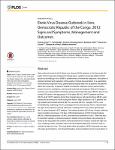Ebola Virus Disease Outbreak in Isiro, Democratic Republic of the Congo, 2012: Signs and Symptoms, Management and Outcomes
Kratz, Thomas
Roddy, Paul
Oloma, Antoine Tshomba
Jeffs, Benjamin
Ciruelo, Diana Pou
Rosa, Olimpia de la
Borchert, Matthias
Data collected during the 2012 Ebola virus disease (EVD) epidemic in the Democratic Republic of the Congo were analysed for clinical signs, symptoms and case fatality of EVD caused by Bundibugyo virus (BDBV), establishment of differential diagnoses, description of medical treatment and evaluation of the quality of clinical documentation. In a quantitative observational prospective study, global epidemiological data from 52 patients (34 patients within the community, 18 patients treated in the Ebola Treatment Centre) were entered anonymously into a database, subsequently matched and analysed. Relevant findings include an over-representation of females among community EVD cases (85.3%) and of community EVD cases in the age group of 15-54 years (82.4%). All ETC patients had fever (55.6% of all 18 ETC patients during their hospital stay) or self-reported fever (88.2% upon admission) at some point of time during their illness. Major symptoms of ETC patients during hospital stay included asthenia (82.4%), anorexia (82.4%), myalgia (70.6%), sore throat/difficulty swallowing (70.6%), arthralgia (76.5%) and nausea (70.6%). Gastrointestinal signs and symptoms (nausea, diarrhoea, vomiting) (76.4%) as well as general pain (94.1%) were frequent in ETC patients. The median duration of EVD was 18 days, while the mean incubation period was 11.3 days. Differential diagnosis of EVD included malaria (28.3%), intestinal parasitosis (10.9%), and infectious syndrome (10.9%). There was also an important variation in clinical evolvement. Quality of documentation was adversely affected by the way patient file contents were transferred from inside to outside the high-risk zone, entailing a mean mismatch value of 27.3% between patient file contents inside vs. outside the high-risk zone. This study adds further description of EVD (frequently non-specific signs and symptoms, non frequent bleeding, a long incubation period, long duration of disease) and emphasizes the need for improving clinical monitoring and documentation in EVD outbreak settings.
Dateien zu dieser Publikation
Keine Lizenzangabe
Verwandte Publikationen
Anzeige der Publikationen mit ähnlichem Titel, Autor, Urheber und Thema.
-
2014-04-10ZeitschriftenartikelResults of surveillance for infections with Shiga toxinproducing Escherichia coli (STEC) of serotype O104:H4 after the large outbreak in Germany, July to December 2011 Frank, Christina; Milde-Busch, Astrid; Werber, DirkAfter the massive outbreak of infections with Shiga toxin-producing Escherichia coli (STEC) of serotype O104:H4 in Germany in the summer of 2011, post-outbreak surveillance for further infections with this type of STEC was ...
-
2015-08-27ZeitschriftenartikelTransmission patterns of human enterovirus 71 to, from and among European countries, 2003 to 2013 Hassel, C.; Mirand, A.; Lukashev, A.; Terletskaia-Ladwig, E.; Farkas, A.; Schuffenecker, I.; Diedrich, Sabine; Huemer, H. P.; Archimbaud, C.; Peigue-Lafeuille, H.; Henquell, C.; Bailly, J.Enterovirus 71 (EV-71) is involved in epidemics of hand, foot, and mouth disease (HFMD) and has been reported to occur with severe neurological complications in eastern and south-east Asia. In other geographical areas, the ...
-
2009-02-19ZeitschriftenartikelEpidemiology of vertigo, migraine and vestibular migraine Lempert, Thomas; Neuhauser, HanneloreBoth migraine and vertigo are common in the general population with lifetime prevalences of about 16 % for migraine and 7 % for vertigo. Therefore, a concurrence of the two conditions can be expected in about 1.1 % of the ...

